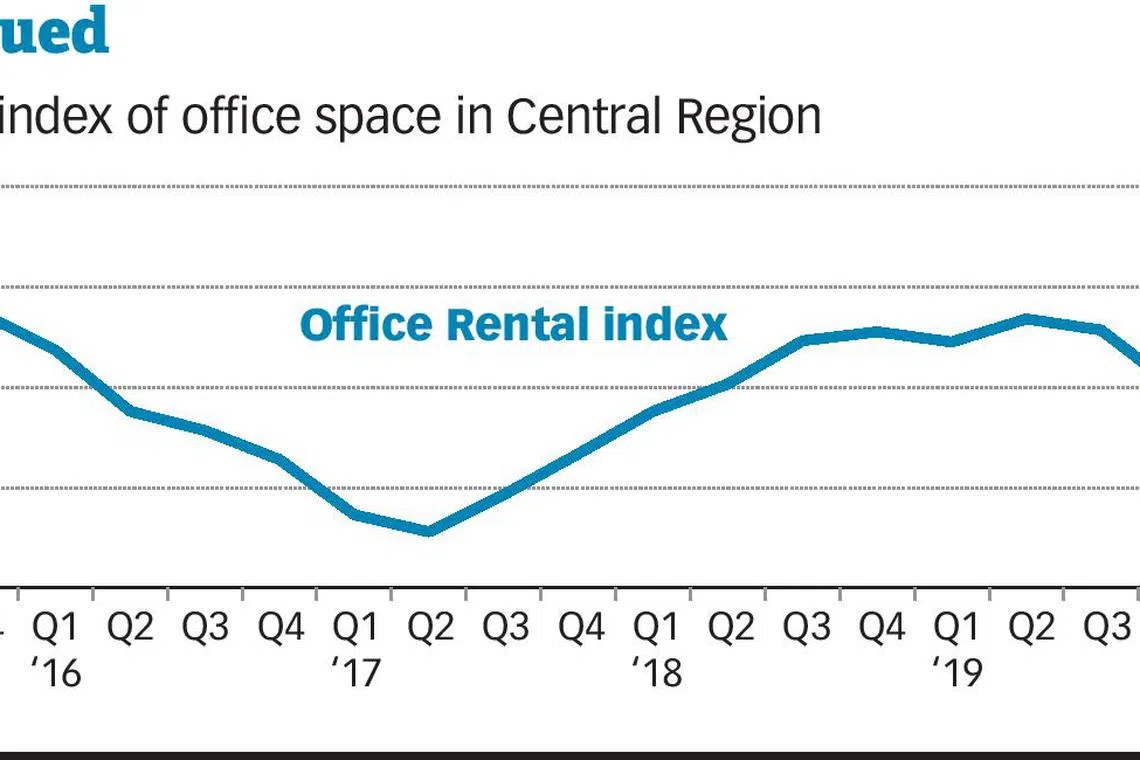Office rents flat in Q2, but vacancy rises to 12.1%
This stems from businesses tightening their belts; leasing driven by renewals or relocations

Singapore
NET absorption of office space in Singapore shrank by a record 55,000 square metres of net lettable area in the second quarter of this year.
Meanwhile, the island-wide office vacancy rate climbed to 12.1 per cent from 11 per cent at the end of Q1 2020, according to data from the Urban Redevelopment Authority.

There is no denying that office demand has weakened amid the recession triggered by Covid-19, but JLL Singapore's head of research and consultancy, Tay Huey Ying, put some perspective to the sharp drop in net demand for island-wide office space in Q2:
"The bulk of the decrease in the amount of occupied office space took place in the Downtown Core, as a result of HSBC Singapore's relocation from 21 Collyer Quay to Marina Bay Financial Centre Tower 2 in the second quarter, so 21 Collyer Quay has been temporarily removed from stock for refurbishment.
"Its new tenant, WeWork, is scheduled to move in only in 2021."
Navigate Asia in
a new global order
Get the insights delivered to your inbox.
Excluding the effect of HSBC's move, Ms Tay estimates that island-wide net demand for office space would have contracted by 30,000-35,000 sq m in the April-June period of this year.
"The last time net demand shrank by this amount was during the Global Financial Crisis, with declines of 34,000 sq m in Q4 2008 and 30,000 sq m in Q1 2009."
In Q1 2003, during the Sars outbreak, the amount of occupied office space contracted by 54,000 sq m, she added.
The record reduction in the amount of occupied office space on the island in Q2 2020 follows a drop of 7,000 sq m in the first quarter; that was the first decline in 12 quarters.
CBRE's head of research for South-east Asia, Desmond Sim, attributes the bigger contraction in net demand in Q2 to businesses tightening their belts across an array of industries. "Cost containment continues to be a key focus. Leasing activity was primarily driven by renewals or relocations, with more firms downsizing from their current footprint," he added.
URA's rental index for office space in the central region of Singapore remained unchanged in the second quarter of 2020 over the previous three months. This compares with a 0.8 per cent drop in the first quarter of this year.

A split of the Central Region office rental index shows that, while rents in the Central Area declined 2.3 per cent q-o-q in Q2 2020, the rental index for the fringe area rose 1.1 per cent over the same period.
Wong Xian Yang, associate director of research for Singapore and South-east Asia at Cushman & Wakefield, expects Singapore office rents to fall in the second half of this year, as more tenants give up space and vacancies rise.
JLL expects its gross effective average monthly rental value for the CBD Grade A office market to fall by about 12 per cent for the whole of this year, contrasting with a 5.4 per cent increase last year
That said, Colliers International's head of research for Singapore, Tricia Song, expects demand drivers in 2020 for CBD Grade A office space to come from the technology sector, which is still growing, as well as flexible workspace due to previously committed leases. "However, new take-up by flexible workspace operators could consolidate after building up a significant presence in the past three years."
On a more positive note, Ms Tay of JLL said that the current market downtime is spurring redevelopment interest in the CBD. If this materialises, it could help to rebalance demand with supply and aid in office sector recovery.
"Displaced tenants looking for replacement work premises would help in space absorption, while demolitions and potential construction delays due to Covid-19 will moderate supply growth. In the medium to longer term, a refreshed CBD will sharpen Singapore's edge as a global office hub," she added.
URA's price index for office space in the Central Region fell for the fourth consecutive quarter. The index posted a 4.3 per cent q-o-q decline in Q2 2020, after easing 4 per cent in the previous quarter.
The Q2 2020 decline was the sharpest q-o-q decline since Q1 2009, when prices fell 12.0 per cent, noted Mr Wong of C&W.
"The steep fall in prices is a reflection of short-term risks to the office market such as recession concerns and social distancing measures, which has led to lower utilisation of office spaces," he added.
Mr Wong expects office prices to decline further. "The market may witness some opportunistic distress purchases as some owners cash out to meet business obligations."
Nonetheless, Singapore office mid- to long-term fundamentals remain unchanged, given limited strata office supply and Singapore's position as a gateway city in the Asia-Pacific, he added.
Decoding Asia newsletter: your guide to navigating Asia in a new global order. Sign up here to get Decoding Asia newsletter. Delivered to your inbox. Free.
Copyright SPH Media. All rights reserved.
